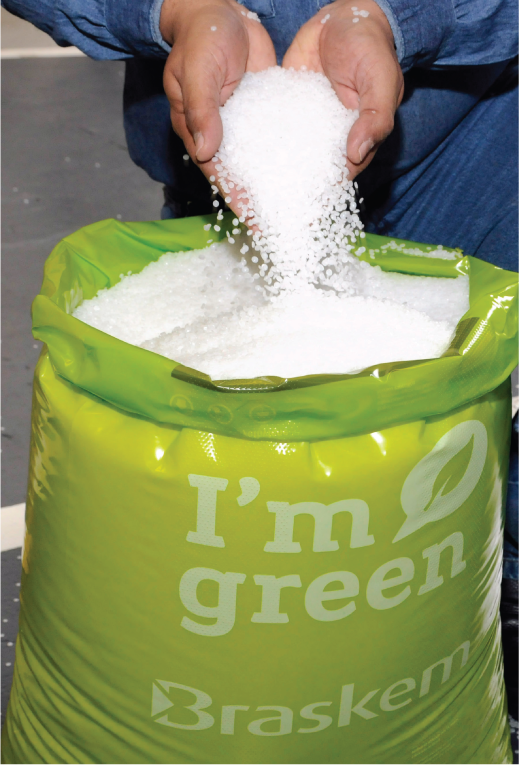Raising the Bar for Blow Molding
Various materials, machines, methods, and “marvels”—like these examples—will be standouts at the upcoming 2014 Annual Blow Molding Conference
Previous Article Next Article
By Geoff Giordano
Raising the Bar for Blow Molding
Various materials, machines, methods, and “marvels”—like these examples—will be standouts at the upcoming 2014 Annual Blow Molding Conference
Previous Article Next Article
By Geoff Giordano
Raising the Bar for Blow Molding
Various materials, machines, methods, and “marvels”—like these examples—will be standouts at the upcoming 2014 Annual Blow Molding Conference
Previous Article Next Article
By Geoff Giordano

Braskem is “promoting sugarcane-based polyethylene for blow-molding applications in the USA” (photo courtesy of Braskem).

Bekum’s all-electric machines can be faster—and cleaner—than hydraulics (photo courtesy of Bekum).

Bekum’s all-electric machines can be faster—and cleaner—than hydraulics (photo courtesy of Bekum).

Plastics Technologies’ “bottle-in-bottle” BrightPak design is an award-winning approach to protecting valuable semiconductor fluids.

“Orange slice” handled PET bottles show literally the shapes of things to come in blow molding (photo courtesy of Bekum).
“The use of all-electrics “is more driven by the desire to eliminate hydraulics and the associated maintenance and potential contamination. ” —Gary Carr, Bekum
Racking up awards from your peers in the blow-molding sector is a sure sign you’re on the right path in bringing innovation to the marketplace. Among the top part winners lately (discussed below) are Plastics Technologies’ bottle-in-bottle package for semiconductor production and a fuel tank by Kautex Machines that allows parts to be placed inside it during the molding process.
Not to be overlooked, of course, are the trends in materials and machines that are every bit as essential as milestone products. A survey of some members of SPE’s Blow Molding Division reveals the most notable advances in this area.
Materials and Machines
“Europe uses a lot of bimodal polyethylene for blow molding, while in the USA the bimodal resins haven’t been used to any great extent,” says Terry Glass, treasurer of the Blow Molding Division and a technical strategy leader at Braskem. “Bimodal HDPE resins have better performance versus unimodal HDPE resins, but they also have different processing characteristics that require new molds and tooling. Industry in the USA is built around unimodal polyethylene resins that have very different die swell properties.”
While Europe typically uses bimodal resins in smaller applications, the high volume of unimodal polyethylene products (milk jugs, oil-quart containers) in the USA means there isn’t as much economic incentive to retool for lower volume applications, Glass explains.
The challenge domestically, he asserts, is that blow-molded products made for the European market will have to be made with bimodals to be competitive. While a push to export polyethylene will spur investments in production plants in the next five years, “I don’t know that there are going to be any domestic markets for blow-molded bimodal-type resins.” It seems likely, he says, that as blow-molding production equipment wears out in the USA, converters are likely to retool to take advantage of bimodal resins—but these conversions will be slow.
Bimodals typically have much better environmental stress crack resistance. “You can also lightweight a little bit—maybe 10 to 15%—and maintain the same top-load properties.” Smaller containers (one to two gallons) could be a segment that benefits from the use of bimodals.
Biopolymers are also gaining traction. Braskem “is promoting sugarcane-based polyethylene for blow-molding applications in the USA,” Glass says. “These are being used in niche applications where the brand owner or consumer recognizes the value a renewable feedstock resin brings.” Such resins are finding their way into segments like health and beauty, home care and specialty-food packaging.
“We’re one of the first places to stretch blow-mold polylactic acid,” says Scott Steele, councilor and finance-audit-nominations chair of the Blow Molding Division and president of Plastic Technologies. “There is work going on in laboratories to learn how to blow mold some of these biopolymers and convert them into useful articles.”
In terms of machines, all-electric blow-molding equipment is gaining ground in Europe as a way to improve energy efficiency and precision while avoiding the costliness of maintaining hydraulics. “Energy in the USA is much more affordable,” says Gary Carr, marketing chair for the Blow Molding Division and director of sales for Bekum. Therefore, that cost consideration doesn’t drive adoption of the equipment.
“It is more driven by the desire to eliminate hydraulics and the associated maintenance and potential contamination. When a hydraulic system has a leak, it can be pretty messy to clean up.” But “you’re seeing increased awareness of all-electric technologies, and the marketplace in North America is starting to seek more information on it. It may become more prevalent.”
Performance-wise, all-electric machines “can arguably be slightly faster,” Carr notes. “The downside is they are typically going to be more expensive.”
As a maker of extrusion blow-molding equipment, Bekum deals primarily with olefin-based materials (high- and low-density polypropylene). “Half the total blow-molding material usage is PET,” Carr says. “PET is overwhelmingly produced with injection-molded pre-forms and then either reheat-and-stretch blown or, in what’s called a single-stage machine, indexed into the blow station. PET extrusion blow-molding has been getting a lot of attention in the past five years. That allows us to make bottles with handles that cannot be produced from an injection-molded pre-form.”
A challenge for equipment makers, Carr says, will be to “make operation of the machinery smarter in terms of trying to minimize complexity—making it more self-regulating and self-adjusting. What we find in the plant environment in the manufacturing world is that the level of technical skill sets may not be keeping pace with the technological improvements.”
Besides maintaining performance, repeatability, and accuracy, cost containment will be a significant motivator. “The packaging sector is a very price-sensitive market segment,” Carr stresses. “If you can save a gram of material over millions of bottles, it’s a big deal. That’s an area that machine builders and processors will be converging on to get those increased performance efficiencies.”
Methods and Marvels
The more unique advancements in blow molding, Carr says, “are often in the large-part arena,” like structural components, table tops, and seat backs (potentially even made with carpet in the mold). Thanks to blow molding, “a hollow part can be very light-weight, yet with good design, can be quite strong.”
That magic combination of form and function has been exemplified by Plastic Technologies’ multiple-award winning BrightPak Liquid Dispenser with collapsible inner liner. Not only was the package honored at the 2013 Annual Blow Molding Conference (ABC 2013), it earned accolades in SPE’s new “Plastics for Life” competition at ANTEC® 2014 in April (see also p. 23 of the June Plastics Engineering).
BrightPak represents a trend “in reheat stretch blow molding in that people are starting to use the process to make more technical parts than just bottles that hold soft drinks and liquid detergents,” Steele says. What his company has achieved “has been well-addressed in the extrusion blow molding side of our business” Steele notes, “but for us it’s a new area we’re exploring: How to make dispensing packages and parts that have multifunction or multicomponent characteristics.”
The dispenser “is an engineered package, a technical part that is more challenging than a traditional application,” Steele explains. “The way (our customer) wants to dispense this product is to blow a bottle in a bottle and collapse the space between the two to force the product out through the connection to the inner bottle.”
While that idea is being used, for example, for beer kegs in Europe and is a staple in the aerosol industry, “we’ve worked hard on the solution of how to make the inner bag collapse appropriately, as well as work with a more difficult-to-blow material on the inner wall called PEN (polyethylene naphthalate) that’s compatible with the products the customer wants to use.”
Durability is key. “The products put in the BrightPak are very expensive,” Steele says, “so [the customer] doesn’t want that thing to break. We’ve done a lot of rigorous testing; it is engineered to withstand a lot more severe conditions.”
Another recent award winner is Kautex Machines’ innovative blow molded fuel tank, which also earned honors at ABC 2013. “It’s something we came up with a few years ago that is going to be put in production very soon with our partner, Vitec,” says Chuck Flammer, vice president of North American sales for Kautex. “It’s a method of inserting parts inside the fuel tank as the parison is coming out of the head hot, versus previous ways where they used to put things on the outside of fuel tanks and weld them on, or weld inside the fuel tank after the tank is molded.”
Kautex’s method reduces emissions, Flammer says—an important outcome given the EPA’s more stringent regulations on the automotive industry. “This can be used on every type of fuel system today.”
While there were previous methods of inserting parts into the fuel tank, Flammer recalls, “the fuel tank had to be a certain shape to have enough room inside to stick these pieces up through the end of the empty parison. Today we cut the parison 360 degrees all the way around the fuel tank, open it, and put everything inside.”
Kautex makes 80-85% of all fuel tank machines in the world, Flammer notes. “We’ve been working on different technologies for different customers; this is a technology we’ve developed ourselves.” The machinery required “is retrofittable on all our equipment, so it doesn’t have to be a dedicated machine for this process; we have components on the machine and in the mold.”
In the future, “we can probably have customers come up with an internal structure they can insert into a tank to strengthen the sides of it and lower the wall thickness to make it lighter. The real concept now is to be able to put baffles and other normally exterior devices inside the tank. It does allow for more fuel to be put into the area the fuel tank takes up, because all your parts are inside. We’re not making room on the outside for these parts; therefore, we have a little more volume in the tank for the same projected area inside the vehicle.”
Note:
SPE’s 30th Annual Blow Molding Conference will take place October 5-7, 2014, in Chicago, Illinois, USA; learn more at www.blowmoldingdivision.org.
